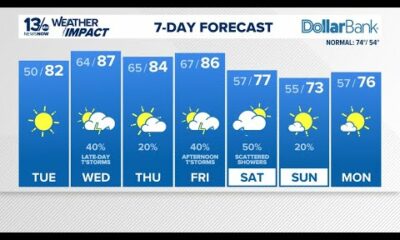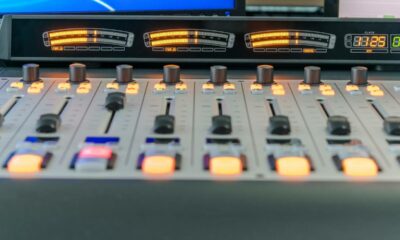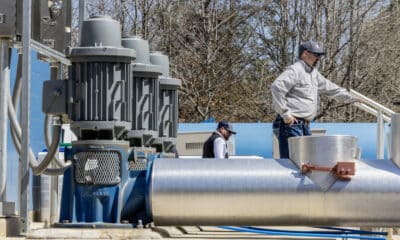News from the South - North Carolina News Feed
Will we even try to prevent future flooding? If past is prologue, probably not • Asheville Watchdog
Some documents age better than others.
And some? They make you cringe – a lot.
Take this June 2016 news release from the City of Asheville. The headline alone has to make anyone in western North Carolina shudder:
“100 years after the Flood of 1916, the City of Asheville is ready for the next one.”
Yeah, not so much.
You can read the entire release here, but I’ll provide some highlights.
“By any measure Asheville’s catastrophic Flood of 1916 stands as ‘The Flood by Which All Other Floods Are Measured,’” it starts off.
It continues:
“When two tropical storms converged on the mountains in tandem that summer — one from the Gulf in June followed by another from the Atlantic in July — the water that thundered in its wake wasn’t just ‘high;’ it carved away the ground under mountain railroad passes, leaving tracks looking like sky-high trapeze rigs hanging 20 to 60 feet in the air.
Dams breached. Eighty people died.
Never before had so much rain fallen in the United States in a 24-hour period, the National Weather Bureau reported.
Sound familiar? Other than the dams breaching, it’s pretty eerie.

To be fair to the city, it did put in place better procedures for emergency notifications and protocols, and it embarked on a major plan to improve the North Fork Reservoir’s dam and spillway, actually adding an additional spillway as an auxiliary. This isn’t in the release, but the city also installed the bypass line after the 2004 flood, and that’s the pipe that — after being replaced — is providing water to the city right now.
The water is kind of beige, but you can use it to flush toilets and take showers. It’s progress.
The 2016 release acknowledged that “climate change can bring more frequent and stronger weather events.”
“The floods will come,” the release states. “Whether it’s through City policy on building in flood zones, updating the City’s flood action plan or ensuring special rescue training for first responders, the City of Asheville takes a multiple pronged approach to ensuring safety for its residents.”
A city official touted the flood operations plan.
“Those plans, coupled with an unprecedented ability to notify residents of imminent danger through mobile phone technology and computers, greatly lessens the risk of a catastrophic loss of life when major flooding comes to call,” it states. “And based on both history and future meteorology modeling, it will.”
As of Friday, the number of Buncombe County fatalities stood at 42.
The release asked a rhetorical question: “One hundred years after the Flood of 1916, Asheville collectively wonders, “Can it happen again?”
“The answer is yes. And no.”
Ugh. The release said modern meteorology provides more warnings, and FEMA’s mapping systems can predict better where flooding will occur, and the city has detailed emergency preparedness plans in place, and “procedures for monitoring river flow and managing capacity at North Fork Dam.”
And we see what happened. Clearly, that release’s main ingredient was hubris.
Joe Minicozzi, a certified city planner and the principal of Urban3 planning group in Asheville, has at times criticized the City of Asheville. He sent me the 1916 release, which I was familiar with. He also sent a link to the “Flood Damage Reduction Task Force’s Presentation to Buncombe County Commissioners” in September 2007.
“I’ve been watching from afar, and I can’t help having some deja vu all over again,” Minicozzi said.

That report noted:
- “Nine major floods have occurred in the past 100 years. The most serious were in 1916 and 2004, but there have been damaging floods on an average of every 20 years.
- Building has occurred first along the river because that is the accessible land and the most easily traversed.
- Census data indicates that there will be an additional 30,000 people in Buncombe County over the next 20 years, putting continued pressure to build along the river in the floodplain.”
That certainly came to pass.
Under “Recommendations to Reduce Flood Damage,” the report urged, “Keep it out! Slow it down! Get it out of the way!”
Suggestions were to “initiate incentives or requirements to ensure low impact development,” along with stormwater management and a reduction in impervious surface and steep slope development. It also encouraged removal of flood-prone structures.
Flooding – a giant, complex issue
It noted, “We are all connected by the watershed and need to ‘share in the pain’ and the solution. For this reason, we need a regional approach.”
I’m really not here today to dump on the city or the county. They both have taken some steps to mitigate flooding, and a lot of work has gone on.
The city spent a fortune on upgrades to the North Fork dam, including adding an auxiliary spillway, and that played a key role in protecting the dam during Helene. All kinds of emergency planning has gone on with the city and the county, and all the fire departments, volunteer and professional.
New buildings in Biltmore Village have been built higher up. Sure, they still flooded in numerous cases, but they adhered to a stricter code.
The problem is that flooding is just a mondo-huge, gigantic complex issue.
A couple of weeks ago when the Small Business Administration administrator was in town, I asked Asheville Mayor Esther Manheimer about the longer-term, big-picture solutions. We were standing in Biltmore Village, near a restaurant that flooded up to the second floor.
“I know that over the years, larger scale stormwater projects have been discussed,” Manheimer said. “For example, there was one that would have created some kind of a dam system all the way out by Warren Wilson (College), that, if I understand the engineering around it, would mitigate flooding in this area.”
That idea emerged after the 2004 flooding, which as the city’s release noted, killed 11 and damaged 16,234 homes.
Manheimer said any large-scale mitigation effort would be “very costly, and sort of a regional need for our area.”
“With projects like that, the barrier is money,” Manheimer said. “But this may be an opportunity to be able to think about those large-scale projects and not just upgrading and improving the stormwater system in the city, because you have to do something larger like that in order to prevent this sort of flood event.”
Manheimer said a gigantic project might not even have prevented the Sept. 27 disaster.
In the “perfect timing” department, Chris Joyell, director of healthy communities for MountainTrue, the Asheville-based environmental nonprofit, called me Friday to chat about the story Victoria Ifatusin and I published Sept. 17 abou the possibility of more frequent catastrophic storms in the area.
Joyell also has served as director of the Asheville Design Center since 2009. The center, which merged with MountainTrue in 2017, connects volunteer designers with projects “that promote healthy, vibrant, and equitable communities.” Previously, Joyell worked with the Nature Conservancy, the Connecticut River Watershed Council, and League of Conservation Voters.

He said he was calling because his experiences over the past 20 years have impressed on him “a need to really rethink the positions that we’ve taken on this redevelopment and what the future looks like.”
“We have some really uncomfortable conversations to grapple with, and I want to make sure that we do that before flood amnesia sets in again,” Joyell told me. “That’s really how quickly we need to turn it around.”
The spirit of rebuilding runs strong here, he acknowledged, and he gets that. So do I. People have invested their money, sweat, tears and lives into their homes and businesses, and they don’t want to just throw in the towel.
Joyell understands that people want to show resilience.
“But I really think that we need to re-examine what we’re doing in our floodplains and recognize that we’re in a changing world,” he said.
As Manheimer said, this might be a good time to shoot for the stars, so to speak. As Joyell put it, the chances of getting something big done diminish “with every day we get further away from Sept. 27.”
‘A lot that’s going to require a lot of money’
“That’s my biggest concern,” Joyell said. “And I do agree that there’s a lot that’s going to require a lot of money. And I think we have a window right now where the legislature is actually willing to consider the needs of western North Carolina. That’s a rarity.”
Joyell pointed out that Hurricane Milton hit Florida right after Helene devastated our area, and the focus can shift quickly with “cataclysmic events that are starting to stack up.”
“It seems like every single year, it kind of gets amped up more than the previous year, and I think it becomes harder for us to maintain focus,” Joyell said.
In short, while we still have the physical reminders of this flood, and the loss of so many lives remains vivid, it’s time to get serious about more permanent solutions to our flooding problems.
As that 2007 county report stated, “There is a cost-benefit ratio to consider in flood planning and big-ticket mitigation projects.”
“Research has shown that for every one dollar that is spent on mitigation, approximately four dollars are saved from monies that are eventually spent on correcting damages,” the task force stated.
I doubt that equation has changed much.
In the 2016 release, McCray Coates, the city’s former Stormwater Services Division director, said the department “plays an active role in monitoring runoff patterns and developing systems to manage that water.”
“What we do is provide mitigation to the depth of flooding, but this is an area subject to flooding — and it will flood again,” he said.
We know how true that is. It’s time to get serious about the mitigation plan.
Asheville Watchdog is a nonprofit news team producing stories that matter to Asheville and Buncombe County. John Boyle has been covering Asheville and surrounding communities since the 20th century. You can reach him at (828) 337-0941, or via email at jboyle@avlwatchdog.org. To show your support for this vital public service go to avlwatchdog.org/support-our-publication/.
Related
The post Will we even try to prevent future flooding? If past is prologue, probably not • Asheville Watchdog appeared first on avlwatchdog.org
News from the South - North Carolina News Feed
NC Farm Bureau asks state Supreme Court to strike environmental protections from hog farm permits
SUMMARY: The North Carolina Supreme Court is reviewing a case that could undermine environmental, civil rights, and public health protections linked to the state’s industrial livestock farms. The case challenges three requirements in CAFOs’ general permits—groundwater monitoring, annual reporting, and phosphorus soil testing—originating from a 2014 civil rights settlement addressing the disproportionate impact on people of color and low-income communities. The Farm Bureau argues these provisions should undergo formal rulemaking instead of being imposed through permits. The outcome could affect regulatory processes statewide, potentially increasing uncertainty and requiring legislative action to clarify agency authority.
The post NC Farm Bureau asks state Supreme Court to strike environmental protections from hog farm permits appeared first on ncnewsline.com
News from the South - North Carolina News Feed
Appointment power for election boards remains with NC governor
For the fifth time in a decade, a court has decided that the legislature cannot remove a governor’s power to appoint election board members. During a hearing last week in Wake County Superior Court, a three-judge panel ruled that a law attempting to give the governor’s elections appointment power to the state auditor would make it impossible for the chief executive to do their job as the North Carolina Constitution requires.
Currently, county election boards are comprised of five members, with two each coming from the Democratic and Republican parties. The governor gets to appoint the chair.
The governor also chooses all State Board of Elections members.
Ultimately, those appointment powers can give the governor, and by extension their political party, tremendous influence on election matters.
Since former Democratic Gov. Roy Cooper won office in 2016, Republican lawmakers have made numerous attempts to take that deciding vote away.
Each time, they’ve fallen short.
In this latest attempt, the Republican defendants — Senate leader Phil Berger, House Speaker Destin Hall and State Auditor Dave Boliek — said they will appeal the ruling. While the players are different this time around, the case will undoubtedly end up in the hands of the state Supreme Court.
The state’s highest court has seen this play out before. But that was in 2017 when Democrats held the majority and narrowly struck down a separate attempt.
Eight years later, things have changed. Republicans hold a 5-2 advantage. That could make all the difference.
Appointment power and executive ‘hopscotch’
If courts ultimately side with the legislature, North Carolina will be the first state that grants any elections power to a state auditor.
Usually, that duty goes to a secretary of state, if anyone, but a Democrat won that office in the most recent election.
Ann Webb, the policy director for Common Cause North Carolina, hopes courts see through the “partisanship” of legislators.
But partisanship isn’t necessarily unconstitutional, as legislative attorney Matthew Tilley noted during arguments before the Wake County court.
In response, Wake County Superior Court Judge Lisa Hamilton said if they allowed this maneuver, there would be nothing stopping a future legislature from shifting election appointment power to another executive office, like the treasurer or agricultural commissioner, to ensure their party maintained control.
“I’m hoping that we’re not going to hopscotch around all nine members of the Council of State until we finally land on the one that would be appropriate,” Hamilton said during the hearing.
The court’s order reflected this concern.
While the General Assembly is allowed to assign duties to members of the Council of State, that right stops where the governor’s constitutional duty to faithfully execute the laws begins, the court ruled. The faithful execution of the laws is not a shared duty among all Council of State members, they continued.
Partisanship takes center stage
The final battle is set for the NC Supreme Court.
There, the major dynamic will be “partisan perspectives and allegiance versus constitutional principles,” Catawba College political science professor Michael Bitzer said.
“I think the expectation is that partisanship will be a determinative factor,” he said. “Whether it’s clearly enunciated in an opinion, I think we’ll just have to wait and see.”
Webb agrees. The state Supreme Court has shown a willingness to act in partisan ways, particularly when it comes to giving the legislature power, she said.
“It’s going to be very interesting to watch whether the state Supreme Court is willing to overturn its own precedent or twist the interpretation of its own precedent to allow that (power shift) to happen.”
North Carolina doesn’t have a particularly powerful governor, but that position does come with some fundamental executive power, Webb continued.
“If that gets dissolved piece by piece by the legislature, then we end up with a false pretense of an executive branch, and that’s not how it’s supposed to work and that’s not how voters assume it’s going to work,” she said.
Legislative leaders haven’t exactly shied away from the partisan angle.
In a statement on social media after the Wake County ruling, Hall, the House Speaker, said the Democratic-controlled State Board runs elections like its operating in “a banana republic, making up the rules as it goes.”
Pat Gannon, a spokesman for the State Board of Elections, objected to the characterization.
“These accusations about the bipartisan-run elections in our state are unfortunate and unfounded. In accordance with state and federal law, North Carolina’s voter rolls are maintained through careful processes that protect our elections and the rights of the voters,” he said in a statement to Carolina Public Press.
If the sixth time’s not the charm, Webb hopes legislators will finally stop. Or, at least, take the Democratic route in attaining appointment power: winning gubernatorial elections.
This article first appeared on Carolina Public Press and is republished here under a Creative Commons Attribution-NoDerivatives 4.0 International License.![]()
The post Appointment power for election boards remains with NC governor appeared first on carolinapublicpress.org
Note: The following A.I. based commentary is not part of the original article, reproduced above, but is offered in the hopes that it will promote greater media literacy and critical thinking, by making any potential bias more visible to the reader –Staff Editor.
Political Bias Rating: Center-Left
The content primarily reflects a Center-Left bias due to its focus on the implications of legislative actions concerning electoral processes in North Carolina, highlighting the tensions between Republican lawmakers and the Democratic governor. It emphasizes concerns about partisanship and the influence of political parties on election integrity, while featuring perspectives from advocacy groups like Common Cause, which are generally aligned with progressive values. The content presents legal arguments that defend the governor’s authority in a manner that leans towards retaining Democratic influence in election matters. Overall, the tone suggests a greater concern for maintaining checks on legislative power than for advocating any specific partisan agenda.
News from the South - North Carolina News Feed
Yes, it always seems we have room for one more development, regardless of traffic • Asheville Watchdog
If you’ve never driven Springside Road in South Asheville, it’s a bit of an adventure.

The two-lane road, a popular cut-through between Overlook and Hendersonville roads, is hilly in places, and a little curvy. You don’t want to stop in the road in one of those blind dips, and trying to exit one of the side streets that lead to it can be downright nerve-wracking.
Now a developer wants to put 37 homes on two lots at 93 and 95 Springside, totaling 5.82 acres. Ultimately, it will need a City Council-approved rezoning that allows more density than the current zoning designation.
Not surprisingly, neighbors are not happy about this. About 40 residents filed written comments with the city’s planning and zoning board before its April 2 meeting, and a bunch turned out to speak about it in person.
Now, I know the first thought for some of you is going to be: “Well, there go the NIMBYs again, not wanting anything built in their backyards.”
I get that. We are a city that badly needs more housing, and infill projects where it makes sense.
But what’s interesting to me on this one is this fact: South Asheville has really taken the development bullet for pretty much the whole city over the past decade or so.

Thousands of apartments have gone up in Asheville during that time, as I’ve noted before, and South Asheville, Arden and Skyland have borne the brunt of that development. If you’ve ever had the joy of driving Hendersonville or Sweeten Creek roads at rush hour (which now seems to run from about 7 a.m.-10 a.m. and 3:30 p.m.-6:30 p.m.), you know what I mean.
It’s a crowded mess.
At that April 2 meeting, John Maddux, whose backyard abuts Springside, put it nicely. Maddux is a deputy city attorney for Asheville, but he made it clear he was speaking as a resident, not in his official capacity.
“South Asheville has already absorbed multiple large-scale developments very close to the site,” Maddux said. “Hundreds of units are going up on Long Shoals Road. Drive down Sweeten Creek Road. Hundreds of units are going in down there.”
Maddux noted that all of this is since the data went into the city’s “Missing Middle” housing study that suggested Asheville needs much more housing, particularly dense types that include apartments, duplexes, townhomes and more.
His point was that “South Asheville is doing its part.
“The plans that we have put to the city all say that density should be distributed equitably around the city,” Maddux said. “It would be inequitable to keep pushing density into South Asheville. I know this is 37 houses, but this is 37 houses in an area that’s not supposed to take 37 houses.”
To me, that’s the gist here. It’s an already crowded area with a large population, not to mention four schools within a few miles and busy commercial strips nearby.
Residents’ emails repeatedly brought up safety concerns about the lack of sidewalks along Springside and how dangerous that road can already be. Quite a few also said they’re not opposed to development on the vacant, wooded site, but they just want it scaled back.
“I am not opposed to this land being developed, as I understand that Asheville is growing and housing is needed,” Barbara Reeves wrote. “But developing this land needs to be done reasonably, thoughtfully, and responsibly.”
She said she’s spoken with many community members who just want a chance “to work together with the city and with a developer,” so they can “propose a solution that is in keeping with the surrounding neighborhoods.”
That April 2 meeting lasted more than three hours, and when the planning and zoning board asked the developer to consider changes to the project, its lawyer asked for the meeting to be continued. The board voted to table the matter until the May 7 meeting.
Here’s an interesting point, though, as pointed out by one of the board members: By right and current zoning, the developer can build 31 units on the site “and doesn’t have to ask anyone’s approval.”
‘The balancing act’ and steadily increasing traffic
Planning and zoning board member Jason Seickel was pretty blunt in one other assessment. Regarding traffic, he said he and other board members have been going down to Springside to drive it, especially in the mornings when school traffic is hitting.
“And yes, I agree that it’s bad, but I mean, unfortunately, a lot of Asheville is bad,” Seickel said, noting that he lives in that part of town and lives the traffic every day. But he also mentioned the housing shortage.
“This commission, we have to balance the needs of individual communities with needs of the larger community as well, too,” Seikel said. “There is a housing shortage. There is a cost-of-living crisis that outside of this room, (the board) also has to deal with, too. So, I hope you understand this — the balancing act.”
Typically that balancing act favors development, partly because of the aforementioned ability to build “by right.” Some of this goes back to old English Common Law and property rights, which run strong in our country — you have a lot when it comes to your property.
Traffic in this area, like much of Buncombe, has only increased in recent years. The NCDOT traffic count map doesn’t provide a vehicles-per-day count for Springside Road, but Hendersonville Road just south of Springside carried 30,500 vehicles a day in 2022. That’s up from 23,000 a day in 2010.
Long Shoals Road, now another major corridor down south, carried 28,500 vehicles a day in 2022, up from 18,000 a day in 2010.
Sure, adding 37 vehicles, or maybe twice that if each household has two cars, isn’t going to break the camel’s back. But it adds to the cumulative effect down south that has been building for more than a decade and has made life unpleasant, if not dangerous at times.
Honestly, if I’m in downtown Asheville after 4 p.m., I just opt to go home to Fletcher via Charlotte Highway and Cane Creek Road, which is five miles longer but 20 minutes faster. That’s mainly because I-26 remains a nightmare until you get to the newly opened lanes in Henderson County, and the other two north-south corridors, Hendersonville and Sweeten Creek roads, are parking lots.

The development does check a lot of the city’s goals
To be fair, it’s not like this proposal is some kind of monstrosity that would make people faint from shock. It is denser than the current zoning allows – it would come out to 6.4 units per acre – but it checks some of the boxes the city wants these days for infill housing.
The developer is listed as Sage Communities LLC of Hendersonville. I reached out for comment but didn’t hear back by deadline.
For the meeting, city planning staff provided a “proposed ordinance change” that states the proposal is consistent with the city’s plan called “Living Asheville — A Comprehensive Plan for our Future.” Staff determined the proposal “to be reasonable, and in the public interest for the following reasons:
a) Prioritizes greater densities of development overall, throughout the city as appropriate
b) Eliminates gaps in the sidewalk network
c) Maintains and enhances buffers and open space preservation along creeks, streams and rivers
The materials also note the subdivision would have three new access points off of Springside Road, and new sidewalks are proposed along the north side of Springside, as well as along both sides of a private road in the development. Additionally, a crosswalk is proposed across Springside Road, although neighbors questioned how safe this would be.

The city’s documents state the development “partially supports” several goals in the Living Asheville plan, including encouraging responsible growth “prioritizing greater densities of development overall,” as that helps achieve more walkable and efficient urban environments.
Also, while the project does propose single-family houses ”at a higher density than the current zoning would otherwise allow, it could reduce the footprint of the development by exploring different building types such as duplexes, townhomes, and small-scale multi-family in order to provide the same number of housing units while disturbing less of the overall site.”
The proposed homes are consistent “with the land use of the surrounding residential neighborhoods,” although they’re more densely packed, the report notes.
The report also says the development will, “Celebrate the unique identity of neighborhoods through creative placemaking — by supporting contextually appropriate infill development and a variety of housing types.”
OK, I coughed up a little lunch on that one. I mean, come on, packing in as many homes as possible is not all that creative.
The planning report dinged the development for not supporting Living Asheville goals including increasing affordable housing, and minimizing the environmental Impact on steep slopes and mature forests and wildlife habitats. It also would increase impervious surfaces.
Further, the report stated: “The proposed project is partially compatible with the surrounding land uses, including: Existing residential neighborhoods to the north, east, and south zoned Residential Single-Family Medium Density District.”
Clearly, neighbors beg to differ on the compatibility issue.
The upshot here is that some version of this development proposal is going to pass, and I suspect it will be one very close to what the developers are pursuing.
Sure, the developer will make some tweaks — save a little open space here, add more buffering there — but the company can build a fair number of units any way you slice it. And will.
And the traffic and safety situation down south, not to mention livability, will get just a little bit worse.
Asheville Watchdog welcomes thoughtful reader comments about this story, which has been republished on our Facebook page. Please submit your comments there.
Asheville Watchdog is a nonprofit news team producing stories that matter to Asheville and Buncombe County. John Boyle has been covering Asheville and surrounding communities since the 20th century. You can reach him at (828) 337-0941, or via email at jboyle@avlwatchdog.org. To show your support for this vital public service go to avlwatchdog.org/support-our-publication/.
Related
The post Yes, it always seems we have room for one more development, regardless of traffic • Asheville Watchdog appeared first on avlwatchdog.org
Note: The following A.I. based commentary is not part of the original article, reproduced above, but is offered in the hopes that it will promote greater media literacy and critical thinking, by making any potential bias more visible to the reader –Staff Editor.
Political Bias Rating: Centrist
This article presents a balanced perspective on the issue of housing development in Asheville, considering both the need for increased housing and the concerns of local residents about density, traffic, and safety. It highlights the challenges of urban growth without strongly favoring either the developer’s or the neighbors’ viewpoints. The tone remains factual and measured, reflecting an attempt to inform rather than advocate for a particular political agenda, which aligns with a centrist bias.
-

 SuperTalk FM6 days ago
SuperTalk FM6 days agoNew Amazon dock operations facility to bring 1,000 jobs to Marshall County
-

 News from the South - Missouri News Feed3 days ago
News from the South - Missouri News Feed3 days agoMissouri lawmakers on the cusp of legalizing housing discrimination
-

 News from the South - Alabama News Feed7 days ago
News from the South - Alabama News Feed7 days agoPrayer Vigil Held for Ronald Dumas Jr., Family Continues to Pray for His Return | April 21, 2025 | N
-

 News from the South - Florida News Feed7 days ago
News from the South - Florida News Feed7 days agoTrump touts manufacturing while undercutting state efforts to help factories
-

 News from the South - Florida News Feed6 days ago
News from the South - Florida News Feed6 days agoFederal report due on Lumbee Tribe of North Carolina’s path to recognition as a tribal nation
-

 News from the South - Oklahoma News Feed7 days ago
News from the South - Oklahoma News Feed7 days agoOklahoma Treasurer’s Office Faces Scrutiny Over Use of Signal in Anti-ESG Coordination
-

 Mississippi Today1 day ago
Mississippi Today1 day agoDerrick Simmons: Monday’s Confederate Memorial Day recognition is awful for Mississippians
-

 Mississippi Today5 days ago
Mississippi Today5 days agoStruggling water, sewer systems impose ‘astronomic’ rate hikes














































